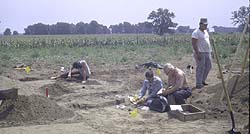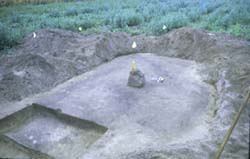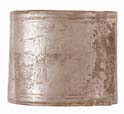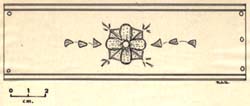
 |
Archaeological excavation at the Waterman site, Randolph County, Illinois, 1971 (ISM transparency) |
The Metchigamia village at the Waterman site was a small stockaded village occupied by several kin based household groups. The village was occupied probably between 1753 and [1765] with a population of only 200-250 persons at any one time. (Margaret Kimball Brown, 1991)![]()
When Jacques Marquette and Louis Jolliet traveled through the Illinois Country in 1673, they were told about a village of the Michigamea tribe of Illinois Indians located in what is today northeastern Arkansas. Under pressure from the Quapaw tribe, the Michigamea moved northward in the late 1600s to live in southwestern Illinois. They resided with the Kaskaskia tribe in the early 1700s and later established their own village (Kolmer site) on the east bank of the Mississippi River, about 3 km from the wooden palisade at the first Fort de Chartres. The Kolmer village was destroyed in 1752 by the same war party that attacked the Cahokia tribe at the River L'Abbe Mission site. The Michigamea then built a new village at the Waterman site, which was located only about 1.5 km from the third Fort de Chartres, a stone fortress then under construction. They remained at the Waterman site until 1765, when they moved west of the Mississippi River to avoid British rule. The site was named for the R. and J. Waterman family, former owners of the land on which the site is located.
Archaeologists from Michigan State University conducted excavations at the Waterman site in 1971. The village is located on a floodplain sand ridge and appears to have been fortified with a trench and stockade. Excavation uncovered the remains of thirteen residential structures that had rectangular, ovoid or circular floor plans. The structures probably had traditional pole frameworks covered with reed mats or bark. However, one house had an unusual concentration of ash and burned soil on one side that may represent a stick-and-mud fireplace modeled after contemporary French construction.
![]()
Excavation of House 1 at the Waterman site, 1971.
Plant and animal remains from Waterman indicate a heavy reliance on corn, white-tailed deer, turtles, and fish in the Michigamea diet. Bison, however, were absent. This pattern is quite different from the earlier occupation at the Zimmerman site, where bison and elk were important. Waterman also differed in that it yielded the remains of cows, pigs, and horses, which may have been raised by the Michigamea as domestic livestock.
Left: Stone Micmac pipe bowl from the Waterman site
![]()
Some traditional artifacts were still being manufactured at this time, including chipped-stone arrowheads, bone tools, and stone pipes.
However, the Michigamea had adopted many items of European manufacture, such as brass kettles, wool clothing, glass bottles, silver bracelets, and crosses made of silver and brass.
Left: Silver braclet with floral design from the Waterman site
Right: Drawing of silver bracelet by Nancy L. Underwood
Other European materials were modified or reworked for new purposes, including arrowheads made from brass kettles, pendants created from pieces of French pottery, and a silver gorget made from the counterguard of a British sword. One unusual artifact, recovered from a child's grave, is a French pistol that dates to the early 1700s. Although the pistol's wooden pieces have not survived, its original quality of construction is indicated by the ornate brass trigger guard and butt plate.![]()
|
|
Copyright © 2000 Illinois State Museum



